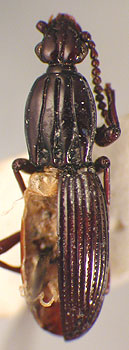Medisorina
Medisores abditus
Ross T. BellIntroduction
This subtribe of Rhysodini contains one genus, Medisores Bell and Bell, with one species Medisores abditus Bell and Bell, at present known only from the type series of four specimens from Ntsubane, Transkei region, South Africa. They were found dead in wood of Cassiopourea gummiflua, var. verticellata, the Onionwood Tree.
Characteristics
Medisores abditus is 5.8-7 mm long. The head sculpture is unique: the median head lobe is separated from the temporal lobes by fine, shallow grooves. The median lobe is tapered evenly posteriorly. There is no trace of an occipital pit and the central cavity of the head is thus apparently absent. The orbital groove is deep and reaches the posterior margin of the temporal lobe. The minor setae of each outer antennal segment are arranged in a complete subapical ring (present on segments V-X). The eye is longer than wide and protuberant. The hind wing is vestigial.
Relationships of Medisorina to Other Rhysodines
Medisores is a very isolated genus. The extreme reduction of the head cavity and pits is probably secondary. The rings of subapical minor setae form a character shared with Dhysorina, Omoglymmiina, Rhysodina, and Sloanoglymmiina.
References
Bell, R. T. and J. R. Bell. 1987. A new subtribe, genus and species of Rhysodini from South Africa (Coleoptera: Carabidae or Rhysodidae). Journal Of The Entomological Society Of Southern Africa 50(2): 287-290.
Title Illustrations

| Scientific Name | Medisores abditus |
|---|---|
| Location | Ntsubane |
| Specimen Condition | Dead Specimen |
| Type | paratype |
| Collector | G. A. Hepburn |
| Image Use |
 This media file is licensed under the Creative Commons Attribution License - Version 3.0. This media file is licensed under the Creative Commons Attribution License - Version 3.0.
|
| Copyright |
© 2001 David R. Maddison

|
About This Page
Ross T. Bell

University of Vermont, Burlington, Vermont, USA
Page copyright © 1999 Ross T. Bell
All Rights Reserved.
- First online 14 December 1999
Citing this page:
Bell, Ross T. 1999. Medisorina. Medisores abditus. Version 14 December 1999. http://tolweb.org/Medisores_abditus/1793/1999.12.14 in The Tree of Life Web Project, http://tolweb.org/









 Go to quick links
Go to quick search
Go to navigation for this section of the ToL site
Go to detailed links for the ToL site
Go to quick links
Go to quick search
Go to navigation for this section of the ToL site
Go to detailed links for the ToL site